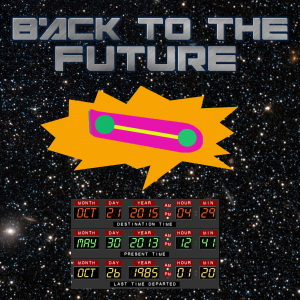
Even though we don’t quite live in a land with flying cars, self-drying clothes and a world without lawyers, the 1989 movie “Back to the Future,” directed by Robert Zemeckis, made a bold prediction of the future that ended up being more right than wrong.
Oct. 21, 2015, was celebrated as “Back to the Future Day,” the day when time-travelling duo Marty McFly and Doc Brown arrived to the future – our present time.
On Back to the Future Day, many long-time fans of the “Back to the Future” franchise witnessed the future unfold. Pepsi distributed a limited amount of Pepsi Perfect, the same futuristic Pepsi we see Marty order in Cafe 80’s in the film. Although only 6,500 were released, the first 200 people dressed as Marty McFly who were fortunate enough to attend The New York Comic Con, received a bottle to take home.
Universal re-released a collector’s edition of the famous cultural phenomena on DVD and Blu-Ray, which includes all three films, the animated series, collectible packaging and bonus content.
Fanatics even had a chance to celebrate “Back to the Future Day” with Doc Brown. Disney set up a Doctor Emmett Brown Facebook profile – a bot that actually interacted with fans. The page had updates about his Time Travel Log to 2015 and his latest inventions, like his brainwave thought-to-text translator.
Not all of Doc’s inventions have been marketed, at least not yet, but a surprising number of “futuristic” gizmos and gadgets predicted by the movie really are available in 2015. Let’s take a look at what this day had in store for us and where our society is compared to the future predicted in “Back to the Future II.” So, grab your hoverboards and come with me on this journey – unless you’re chicken – because, “where we’re going, we don’t need roads.”
One way the future accidentally exceeded the movie’s predictions was the replacement of the fax machine with the Internet. In the scene where future Marty was fired, a device similar to a fax machine is used to send messages to one another. Now, messages are more likely to be sent over the Internet via cellphone, laptop or tablet. In the late ’80s the filmmakers did not foresee the Internet becoming available to people as it is today. At the time, the Internet was still in its development phase. Since the release of the film, the fax machine has almost become obsolete while the Internet is a way of life for most people.
Doc uses another familiar apparatus, similar to binoculars, that displays information about people. Today we have Google Glass, which displays information in a similar hands-free format. This technology is still fairly new to the market, only releasing this past year.
Another futuristic machine used was the cellphone-like device Marlene McFly, Marty’s futuristic daughter, wore on her head. She uses virtual reality to talk on her hands-free headset, which is similar to products like Oculus Rift and Google Cardboard. Today, virtual reality platforms have expanded beyond hands-free messaging and video games into the area of healthcare. Doctors and surgeons use this type of technology when treating complicated diseases and cancers.
When Marty was in Cafe 80’s, he plays the arcade game “Wild Gunman.” After Marty finished, a couple of kids were appalled that players had to use the gun instead of their hands. Now, we have the Kinect for Xbox One by Microsoft that lets you play video games without a controller.
Since the movie’s depiction of the hoverboard, there have been many breakthroughs in developing this product. They do exist, however, the technology only works on ramps made of metal. Although this is a breakthrough in technology, since they cost of $10,000 the use of them is not practical as portrayed in the film.
Another technological advancement from the movie that exists today is the ability to watch six channels at once on a flat-screen television, like future Marty does. Flat-screen televisions now occupy most homes, replacing picture tube TVs. Most flat screens now have the picture in picture option so people can watch multiple channels at once.
In the movie, Doc uses trash as an alternative fuel source for the Delorian. Recycling is nothing new. Scientists are developing new ways to turn recycled garbage into an alternative fuel source, but Willie Nelson has already helped invent bio-diesel from waste vegetable oil, waste fats and seed oil crops, which produces 70 percent less harmful emissions when compared to ULDS (Ultra-low-sulfur diesel).
Marty’s mother uses a device to prepare a pizza by re-hydrating the food with a food hydrator. Although Black and Decker has yet to release a food hydrator, dehydrated foods are used by the military and astronauts because of the cost efficiency, easy preparation, long shelf life and non-dependence on refrigeration.
Nike confirmed that they’re working on self-tying shoes, similar to the Air Mags in the film, at the Agenda Emerge industry conference in Long Beach, Calif. in early 2015. Michael J. Fox finally received a pair of Nike Air Mags after 30 years from Tinker Hatfield, Nike’s designer. Nike announced that they will auction off a limited run of the shoe in aid of the Michael J. Fox Foundation for Parkinson’s Research.
It’s amazing how accurately the film predicted a lot of products that are on the market today. The movie also predicted the Cubs would win the World Series 2015 — at least they made the playoffs; Cub fans may want to take note. Life came close to imitating art once again. Maybe one day Cubs will win the Series again when Delorians fly. At this point I’d even settle for a pair of those Nike Air Mags.

